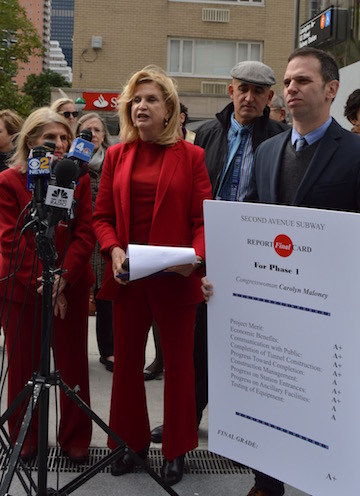
BY JACKSON CHEN | Metropolitan Transportation Authority officials and Congressmember Carolyn Maloney are voicing confidence that the Second Avenue Subway will have its first section operational by the new year.
The first phase of the Second Avenue Subway (SAS) will include new stations at 96th, 86th, and 72nd Streets to connect to the existing system at the Lexington Avenue/ 63rd Street stop. In early October, the MTA began testing the new route, which will become an extension of the Q line.
“The MTA tells me they are 98 percent complete as of October 1,” Maloney said at a press conference on October 25. “There is no doubt… we’re certain that in the greatest city on earth, we are going to have the first major subway opening in 60 years.”
Speaking at a recently opened public plaza at the corner of Third Avenue and 63rd Street — built as a public amenity of the project, adjacent to new exits for the Lexington Avenue/ 63rd Street stop — the congressmember issued her final report card on the SAS’s Phase 1, with an overall grade of A+. Maloney’s report awarded A+ to categories including completion of tunnel construction, progress on station entrances, and construction management, while other areas like progress toward completion, progress on ancillary facilities, and testing of equipment scored A’s.
The congressmember’s previous report card in May offered an overall grade of A-, but several areas earned C grades, including equipment testing, construction mitigation, and transition to Phase 2, which will consist of stations at 110th and 116th Streets and connect to the 4, 5, 6 station at 125th Street. With roughly two months until opening day, Maloney, after talks with MTA, was satisfied that the new subway line would be open, citing more than 90 percent completion for the new stations.
“One of the reasons this subway is so important is that it will alleviate overcrowding on the Lexington Avenue line,” Maloney said. “We know from experience that there is a limit of how many people you can stuff in a subway.”
According to MTA officials, contractors are working double-time to make good on the end of the year opening date. Michael Horodniceanu, MTA’s president of capital construction, said training for the new workers of the SAS line will be completed by November 11 and the trial-run trains are currently “running and running well.”
During their monthly update report to the MTA board this week, independent engineers discussed different aspects of the project and their possible impact on the promised opening date of December 31. Kent Haggas, the independent engineer for the project, said systems testing has been increased significantly but needs to keep up at that accelerated pace.
According to the October progress report, fire alarm testing throughout the stations and escalator testing at the 86th Street station could have potential impact on the opening date.
“We never had an opening quite this large,” Thomas Prendergast, the MTA’s chair and CEO, said. Prendergast commended the team’s work and said “they prioritized what needs to be done… but there are still a ways to go.”
The MTA chair said that progress measures toward completion were positive and pointed to meeting the December 31 opening date.
Even as the agency stuck with its promised opening date, Maloney herself wouldn’t guarantee an exact date, but insisted that the SAS would operational soon.
“It is going to be open, whether it’s the end of December, or January 1 or 2,” Maloney said. “The last thing I want to do is push workers to complete a project that may harm someone by not being fully tested.”
With the Second Avenue Subway rumbling toward completion, the congressmember noted that there is $1 billion in the MTA’s budget for Phase 2. However, she emphasized that politicians had to ensure that the money is actually put to use.
Nick Sifuentes, the deputy director of the transit advocacy group Riders Alliance, said the long-awaited completion of Phase 1 would restore some confidence for commuters, but agreed with Maloney that the MTA must push ahead toward extension of the line to 125th Street. Once completed in full – more than a decade from now – the project will boast 8.5 miles of new subway service from East Harlem to Hanover Street downtown.
“When [the SAS] opens, it’s not just going to serve the commuters who have been waiting for it, it’s also going to demonstrate to the public that investment in mass public transit really yields results,” Sifuentes said. “But it reminds us that we’ve got to get Phase 2 of the Second Avenue Subway funded all the way up to East Harlem.”



































